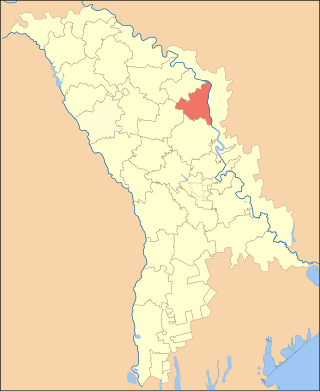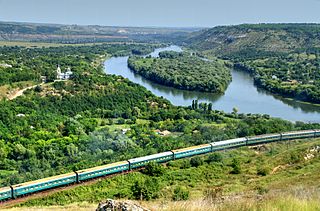
Chișinău, also rendered Kishinev, is the capital and largest city of the Republic of Moldova. The city is Moldova's main industrial and commercial centre, and is located in the middle of the country, on the river Bîc, a tributary of the Dniester. According to the results of the 2014 census, the city proper had a population of 532,513, while the population of the Municipality of Chișinău was 700,000. Chișinău is the most economically prosperous locality in Moldova and its largest transportation hub. Nearly a third of Moldova's population lives in the metro area.

Transnistria, officially the Pridnestrovian Moldavian Republic (PMR), is an unrecognised breakaway state that is internationally recognised as a part of Moldova. Transnistria controls most of the narrow strip of land between the Dniester river and the Moldovan–Ukrainian border, as well as some land on the other side of the river's bank. Its capital and largest city is Tiraspol. Transnistria has been recognised only by three other unrecognised or partially recognised breakaway states: Abkhazia, Artsakh and South Ossetia. Transnistria is officially designated by the Republic of Moldova as the Administrative-Territorial Units of the Left Bank of the Dniester or as Stînga Nistrului. In March 2022, the Parliamentary Assembly of the Council of Europe adopted a resolution that defines the territory as under military occupation by Russia.

Gagauzia or Gagauz-Yeri, officially the Autonomous Territorial Unit of Gagauzia (ATUG), is an autonomous territorial unit of Moldova. Its autonomy is ethnically motivated by the predominance in the region of the Gagauz people, who are primarily Orthodox Turkic-speaking people.

According to the Moldovan law on territorial administrative organisation, Moldova is divided administratively into the following administrative territorial units: districts, cities/towns and villages. The administrative territorial organization of Moldova is made on 2 levels:
- villages (communes), sectors and cities/towns (municipii) constitute the first level,

Edineț is a town and municipality in northern Moldova. It is the administrative center of the eponymous district. The town is located 201 km north of the national capital, Chișinău. It is located at 48°10′N27°19′E. The town administers two suburban villages, Alexăndreni and Gordineștii Noi. The population at the 2004 census was 17,292 inhabitants, including 15,624 in the town itself.

Rezina is a district in the east of Moldova, with the administrative center at Rezina. Rezina is situated on the western bank of the Nistru river. As of 1 January 2011, its population was 52,600.

The Transnistria conflict is an ongoing frozen conflict between Moldova and the unrecognized state of Transnistria. Its most active phase was the Transnistria War. There have been several attempts to resolve the conflict, although none have been successful. The conflict may be considered as having started on 2 September 1990, when Transnistria made a formal sovereignty declaration from Moldova.

Cocieri is a commune in the Republic of Moldova, and the administrative center of Dubăsari District. It is located on the eastern bank of the Dniester River, consisting of two villages, Cocieri and Vasilievca.

Giurgiulești is a commune in the Cahul District of Moldova. It is also a border crossing point to Romania, located 10 km (6.2 mi) from Galați.

Coșnița is a commune located in Dubăsari District of the Republic of Moldova, on the eastern bank of the River Dniester. It consists of two villages, Coșnița and Pohrebea.
Beșalma is a commune and village in the Gagauz Autonomous Territorial Unit of the Republic of Moldova. The 2004 census listed the commune as having a population of 4,441 people, including 4,293 ethnic Gagauz, 44 Moldovans, 37 Ukrainians, 33 Russians, 25 Bulgarians and 5 Romanians.
Tomai is a commune and village in the Gagauz Autonomous Territorial Unit of the Republic of Moldova. The 2004 census listed the commune as having a population of 5,014 people. 4,767 of the village residents were Gagauz. Minorities included 36 Moldovans, 80 Russians, 46 Ukrainians, 37 Bulgarians, 28 Roma plus 20 of other ethnicities.

Naslavcea is a village in Ocnița District and the northernmost point in Moldova. The village, situated along the Dniester river that separates Moldova and Ukraine, has an ethnic Ukrainian majority.
Etulia is a commune in the Gagauz Autonomous Territorial Unit of the Republic of Moldova. It is composed of three villages: Etulia, Etulia Nouă and Etulia station. The 2004 census listed the commune as having a population of 3,649 people. 3,382 inhabitants are Gagauz. Minorities included 31 Russians, 43 Ukrainians, 24 Bulgarians, 164 Moldovans and 1 Greek.
Trușeni is a commune in Chișinău Municipality, Moldova. It had a population of 7,952 at the 2004 Moldovan Census, and is a northwest suburb of the city. The commune is composed of two villages, Dumbrava and Trușeni.
Pleșeni is a commune in Cantemir District, Moldova. It is composed of three villages: Hănăseni, Pleșeni and Tătărășeni.
Ruseștii Noi is a commune in Ialoveni District, Moldova. It is composed of two villages, Ruseștii Noi and Ruseștii Vechi.
Doina is a commune in Cahul District, Moldova. It is composed of three villages: Doina, Iasnaia Poleana and Rumeanțev.
According to the Moldovan law on territorial administrative organisation, two or more villages can form together a commune.
Berlinți is a commune in Briceni District, Moldova. It is composed of two villages, Berlinți and Caracușenii Noi.












